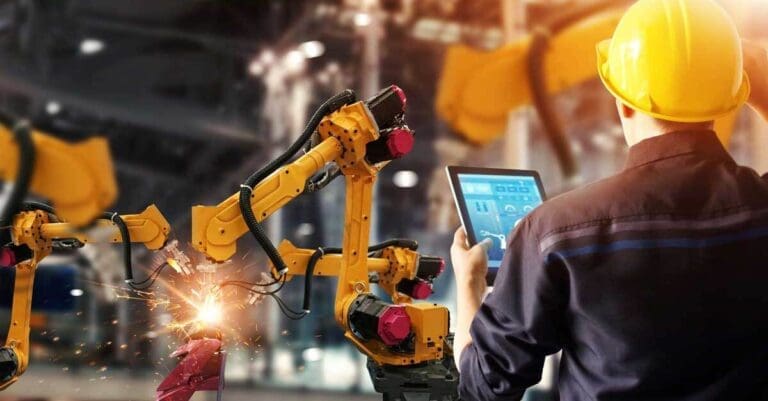
Technology stands as a powerful ally for manufacturers, fortifying their capacity to meet escalating demand, secure a competitive advantage, and bolster efficiency.
Dive deeper to discover how manufacturing companies can harness the transformative power of digital innovation. By redefining their processes, reaping cost savings, and curbing downtime, they can stride confidently into a future where efficiency and profitability coexist.
Things to know about digital transformation in manufacturing:
- What is Digital Transformation?
- Digital Transformation Opportunities in Manufacturing
- Benefits of Digital Transformation in Manufacturing
- Challenges of Digital Transformation in Manufacturing
What is Digital Transformation?
Digital transformation is the process of leveraging digital technologies to transform business processes, services, or operations. It can involve the creation of a new digital process, the maturation of an existing process, or the conversion of an analog process to a digital one.
Digital transformation is not a one-time fix, but rather a continual adaptation to evolving customer needs, environments, and technologies.
4 Digital Transformation Opportunities in Manufacturing
IoT & connected devices
Harnessing the potential of the Internet of Things (IoT) is a game-changer in the digital transformation of the manufacturing industry. Think of IoT sensors as the pulse of your machinery, capturing vast amounts of data ranging from vibration and acoustics to temperature and cycle times. This vital data can then be analyzed to empower decision-making, pinpoint inefficiencies, streamline processes, and minimize downtime.
In addition, connected devices can help track the real-time location of materials and products across your operations. This tracking capability enhances supply chain optimization, offering insights into inventory management and ultimately improving operational efficiency.
Therefore, leveraging IoT doesn’t just transform your manufacturing processes; it strategically positions your company for increased productivity and competitiveness.
Predictive maintenance
The hard truth in the manufacturing world is that the average firm grapples with a staggering 800 hours of downtime per year, with each minute potentially siphoning off tens of thousands of dollars. This reality underscores the urgent need for proactive solutions.
Enter predictive maintenance, a shining beacon in the digital transformation landscape. With this approach, sensors diligently monitor the well-being and performance of equipment, acting as an early warning system. They constantly scan for irregularities in machinery, such as deviation in vibration patterns or a spike in heat signatures. Upon detecting any anomalies, they can instantly alert technicians who can proactively tackle the issue before it escalates.
Predictive maintenance is like a watchful guardian, providing real-time equipment surveillance, thereby cutting down on sudden machinery failures that often lead to crippling downtime and consequential financial loss. This not only improves equipment longevity but also significantly boosts the overall productivity and profitability of the manufacturing operation.
Embracing predictive maintenance is truly a strategic move towards a more resilient and efficient manufacturing ecosystem.
Automation
Automation stands as a linchpin in the digital metamorphosis of the manufacturing industry, bringing with it a newfound level of productivity and precision. The secret weapon here is Robotic Process Automation (RPA), a technology capable of taking on and streamlining repetitive, low-value tasks, resulting in significant cost reduction and heightened operational efficiency.
RPA isn’t just about efficiency; it’s about transforming the way manufacturing operates. It extends its influence across an array of tasks, from the minutiae of data entry to the complexities of inventory management. With mundane tasks handled by RPA, your workforce can shift focus from the mundane to the essential, dedicating their energy to the more nuanced, high-value aspects of the manufacturing process.
So, automation isn’t just about replacing human effort with robots—it’s about empowering your human resources to concentrate on what they do best, while RPA handles the rest. It’s about promoting a symbiotic relationship between human intellect and machine precision for a more productive, accurate, and efficient manufacturing environment.
Cloud computing
As the Internet of Things (IoT) continues its rise, so does the necessity for robust systems that can nimbly and securely handle voluminous data. Here, cloud-based architecture emerges as the ideal solution, breaking the constraints of outdated, monolithic legacy applications. It brings to the table an array of benefits, such as heightened security, the flexibility of remote operations, cost reduction, and a significant boost in agility.
Cloud-based solutions extend their support across the manufacturing landscape. From the intricate realm of supply chain management to the critical domain of quality control, the cloud is there, offering unparalleled access to information whenever and wherever needed.
But this access isn’t merely about data; it’s about fostering a more collaborative and communicative environment. With information at their fingertips, your teams can collaborate seamlessly, while also enhancing communication both internally and externally. This leads to improved interactions with customers and partners, fueling a synergistic ecosystem that thrives on shared knowledge and common goals.
Hence, cloud technology is not just a tool but a strategic asset that fosters a more connected, efficient, and productive manufacturing environment.
Benefits of Digital Transformation in Manufacturing
Harnessing the power of state-of-the-art technology to digitally evolve your manufacturing operations unlocks an array of remarkable benefits:
- Improved efficiency: Embracing digital transformation leads to streamlined processes, reducing waste and enabling tasks to be completed more swiftly and effectively.
- Greater accuracy: Advanced technologies minimize human error, ensuring precise measurements, calculations, and execution in manufacturing tasks.
- Lower costs: By automating repetitive tasks and improving process efficiency, digital transformation aids in significantly reducing operational expenses.
- Reduced downtime: With predictive maintenance and real-time monitoring, digital technologies can foresee potential issues and reduce unexpected downtime in the production process.
- Improved product quality: Utilizing advanced digital tools allows for meticulous quality control, ensuring superior product quality and consistency.
- Greater agility: Digital transformation facilitates quick responses to changes in the market or supply chain, enhancing the company’s adaptability and resilience.
- Tightened security: Advanced cybersecurity measures associated with digital transformation help protect sensitive data, intellectual property, and the integrity of the manufacturing process.
Challenges of Digital Transformation in Manufacturing
Navigating the path of digital transformation in manufacturing can be fraught with challenges. Despite recognizing its potential, many firms struggle to fully harness this transformative power. Key obstacles often include:
- Internal Resistance: Introducing new technologies and processes is a potent strategy for elevation. Yet, these changes can stir up unease and opposition among employees, obstructing smooth adoption and tangible value creation. Effective training and support systems are crucial to ease this transition.
- Infrastructure Integration: The success of digital transformation hinges on its seamless integration with existing IT infrastructure. Rather than existing as a detached initiative, it needs to be woven into the fabric of the organization, evolving in sync with other components.
- Expertise Deficit: The execution of digital transformation calls for profound technical acumen and a meticulously designed strategy. This specialized knowledge may be lacking within manufacturing firms, posing a significant roadblock.
- Communication Breakdown: A thriving digital transformation is underpinned by robust communication. Clear articulation of impending changes and their anticipated benefits is essential, fostering understanding and commitment among all stakeholders. Without this, the transformation journey can quickly derail. It’s about more than mere technological change; it’s about creating a shared vision for a digitally empowered future.
How AIM Consulting Can Help You Reach New Possibilities
AIM Consulting’s strategic approach to applications, platforms, and technology systems can empower your company to simplify operations and take advantage of efficiency gains.
Our digital transformation offerings are designed to streamline your manufacturing operations, slashing manual procedures and modernizing traditional approaches to information and data collection. This elevates your operations to new heights of effectiveness, making your production leaner, smarter, and more future-ready.
Need Help Leveraging Evolving Technology?
At AIM Consulting, we help manufacturing companies accelerate their business workflows by digitizing processes and leveraging strategic tooling and smart automation. Let’s transform your business together.




